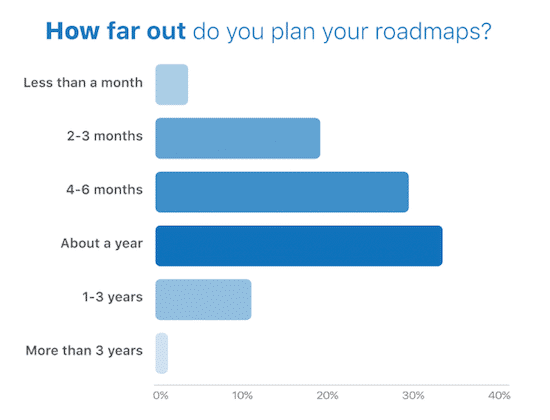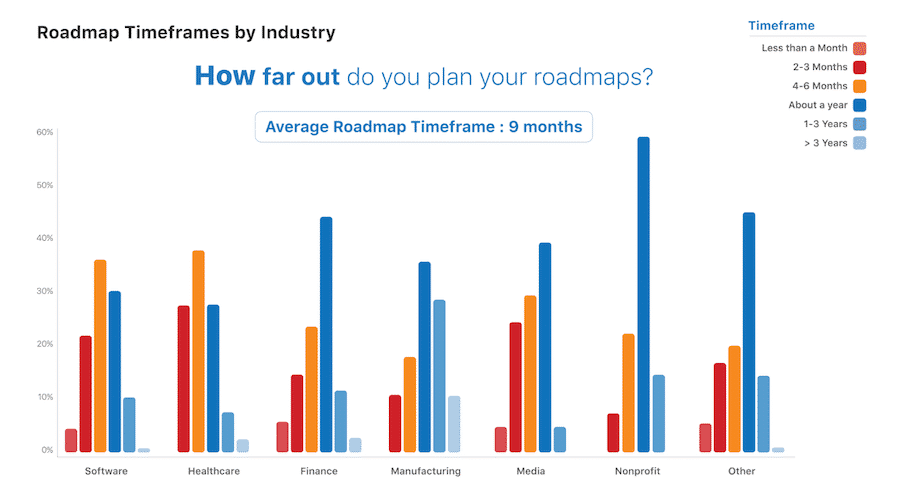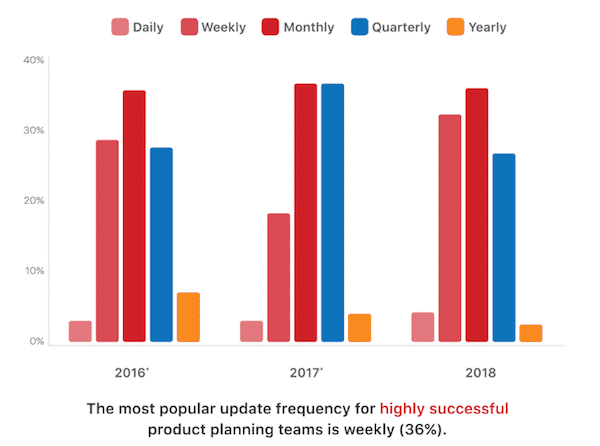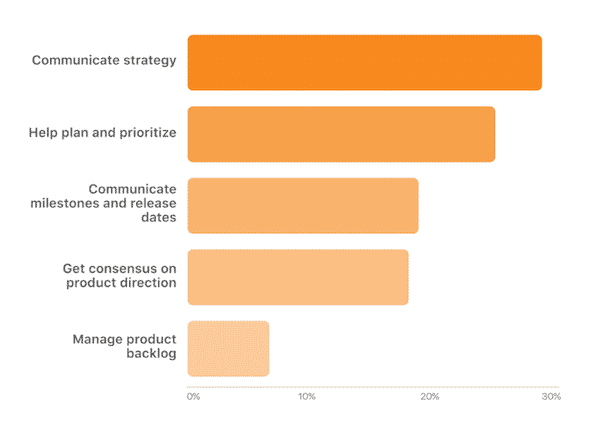Choosing the correct product roadmap timeframe can be challenging even for experienced product managers. If you saw a product roadmap that spanned 15 years into the future, how useful do you think those items set for 4 years from now, 7 years, a decade, would be today? Not very helpful, right?
Now consider the opposite. What about a roadmap that detailed the product’s plan for only the next two weeks? Also, not a very helpful strategic guide, agreed?
Which means that when it comes to product roadmap timelines, there must be a strategic sweet spot. A timeframe not so short-term that it can’t give you a view of what’s to come, but also not planned so far into the future that the long-term items become meaningless.
Product roadmap timeframe sweet spot
According to ProductPlan’s 2018 Product Planning Report, for most product management teams, it’s somewhere between 4 and 12 months.
Among our pool of survey respondents—more than 500 product professionals across many industries—the most common roadmap timeframe is one year out, followed by 4 to 6 months, and the third most common timeframe is a roadmap planned 2 to 3 months ahead.

Of course, these timeframes vary considerably according to industry. As you can see in the graph below, the industry that plans its product roadmaps the farthest out into the future is manufacturing.
This isn’t surprising when you consider that these organizations are producing physical products that need longer lead times. Adjusting their roadmaps is oftentimes a more complicated process than in other industries.
For the same reason, as you can also see in the graph below, software companies report some of the shortest average roadmap timeframes. Software makers can—and often need to—adjust course in product strategy and planning more often than do most other types of companies. This is especially true if the product team overseeing the software’s development uses a highly iterative and fast-paced agile method.

As one product marketer with an enterprise software company explained, “While we plan out a 3-year strategy, agile development really only enables you to have an actionable roadmap 3 to 6 months out. The key is to bounce your current roadmap up against the 3-year plan to understand progress.”
Key stat about product roadmap timeframes and successful prioritization
An important statistic that emerged from the survey is that product teams that keep their roadmap timeframes tighter report better prioritization than those who plan farther into the future.
In fact, teams who told us their roadmap timeframes spanned only 4 to 6 months claimed to have 20% more prioritization success than teams planning more than 3 years out.
Updating the roadmap: Another key to product success
Another important factor to keep in mind when determining how far out into the future your product roadmap should go is how often you’ll be updating it.
The longer your roadmap’s timeline spans, the more likely those items planned far into the future will become inaccurate, outdated, or simply irrelevant. But even if you keep your roadmap’s timeframe relatively tight—say, planning only 6 months ahead—you will still need to revisit that strategic plan every so often to make sure your team is executing on pace and that the plan itself still makes strategic sense in light of any new information coming in.
As you can see from the graph here, our survey found that the most popular update cadence among all product teams is monthly. Among teams that report the highest rates of success, the most common update frequency is weekly (36%).

Why product roadmap timeframes matter
So, why are timeframes and dates important elements to include in your product roadmap? According to our survey, product professionals listed “Help plan and prioritize” their products’ development as the second most important reason to have a roadmap in the first place. Here is a breakdown of the percent of product managers who primarily use roadmaps to achieve the following objectives:

In other words, for many product managers, having a product roadmap without timelines to anchor their plans and prioritize their initiatives would make those roadmaps far less useful in helping them guide their products’ progress.
But does your roadmap need a timeline? We would argue yes, in the sense that you’ll always want to anchor your strategic plans to timeframes (even if they are simply rough estimates).
But no, you do not always have to display timelines and estimated completion dates on your product roadmap—particularly when reviewing your roadmap’s high-level strategic plans with your executive stakeholders or if you choose to share some detail of your roadmap with the public.
Pro tip: The ability to easily “turn on and off” the dates on your product roadmap, based on which audience you’ll be sharing the roadmap with, is a key reason to use a purpose-built roadmap app, rather than trying to maintain several versions of your roadmap using different presentation or spreadsheet files.
As one of our survey respondents explained, “Our difficulty is often to combine a high-level view for customers and executives and a detailed view for the product, development, and customer teams.”
We couldn’t agree more. That’s why we built a tool that lets you switch roadmap views in a single click to display just the right amount of detail for any audience.


